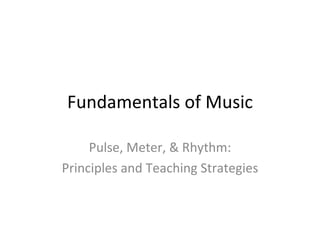
Fundamentals of music pulse, meter, rhythm
- 1. Fundamentals of Music Pulse, Meter, & Rhythm: Principles and Teaching Strategies
- 2. Pulse – 2 Concepts to Consider • Concept #1 – “Feeling” the Pulse – Nature and pulse-lie concepts/activities (heartbeat, clock, walking) • Concept #2 – Internalizing the Pulse – Impact of playing & reading music on student ability to maintain pulse (Multiple Mental Processes). • Must develop both concepts by including them in the curriculum and practicing regularly. • Teaching Strategies must match student’s innate musical skills, musical background, physical maturation.
- 3. Exercises for Pulse Development • Feeling the Pulse – Tapping/Clapping to Recorded Music • Vary tempo, meter, styles of music – Counting Exercises • Aloud & silently • Hand signals (palm up/down) • Macro Pulse versus Sub-Divided Pulse
- 4. Exercises for Pulse Development • Internalizing the Pulse – Walking in time • Walk – 2 – 3 – 4 – Stop – 2 – 3 – 4, etc. – Blowing air into instrument, Silent counting • Vary counting patterns – Air for 6, rest for 3 – Air for 3, rest for 1 – Playing to an Amplified Metronome • The applied lesson experience
- 5. Foot Tapping Technique • Controversial – Reasons for Use • Teacher can see that the student is conscious of pulse, maintaining it, and aware of sub-division. – Reasons for Not Using • Coordination problems • Distracting to audience and other players
- 6. Foot Tapping (cont’d) • Foot Tapping Techniques – Introduce on 1st day – Emphasis on tapping evenly • Muscular control for up AND down movements – Toe or Heel – does it matter? • Large versus small muscle coordination – Recommendation: Use for specific situations • Assist in pulse development • Assist with learning new or difficult rhythms
- 7. Kohut’s Arrow System • A system for counting AND foot tapping • Emphasis on sub-division • Arrow system – Examples on pp. 21, 23 – Use of connected arrows for “longer” duration
- 8. Meter: Principles and Teaching Strategies • Bridge between pulse and rhythm • Organizational system for note reading • Common Problems: only discussing the numeric values. – Need a definition that works for all meters (4/4 – 2/2 – 6/8) • Need a comprehensive definition that includes metric variables – Dotted rhythms – Tied note values – Syncopation – Long/short & short/long sequences
- 9. 2 to 1 Principle • Simple, or duple, meter is based upon this principal • It is the essence of rhythm & the key to understanding meter • Establishes principle of sub-division • Teach students the “family of notes” • Rhythmic Notation Pattern – add one “thing” • For your graphic organizer, utilize a “right-angle” triangle rather than an “equilateral” triangle. • Later, incorporate the 3 to 1 Principle for teaching compound, or triple, meter.
- 10. Developing Musical Literacy • Aural/Oral Method • Analogy: learning a language • 4 parts to musical literacy – Reading – Performing – Writing – Dictation
- 11. Rhythmic Principles: Counting Systems • General Concepts • Need to establish on the 1st day • Many effective types – Need uniform system throughout your school district • Based upon sub-division – count: 1 & 2 & 3 & 4 & with foot tapping & clapping of rhythm • Apply to literature being rehearsed/performed • Students need to write counting in difficult excerpts
- 12. Rhythmic Principles: Kohut Recommendations • Three Counting Systems – see hand-out – Measure counting – Note counting – Beat counting (p. 24 Kohut article) – Other systems • Stacking system • Counting boxes • Eastman system • Gordon system • Kodaly system • Takadimi system • Rhythmic Mnemonics
- 13. Dotted Values & Compound Meter • Power of the Dot • Counting triplets • Counting sextuplets • Using 12/8 to teach compound meter – no 6/8 – Family of Notes & compound meter (12/8) – F am y i
- 14. Teaching Strategies: General Information • Most students are “followers”. • Include written worksheets for in-class activities • Use a variety of exercises for teaching the SAME rhythm • Don’t teach rhythm strictly by ROTE • Never count, clap, etc. WITH the students – Teacher only provides a steady, audible pulse • Students should Count, Clap, and Play • Other resources: – Winning Rhythms, by Edward Ayola – Rhythms & Beyond, by Loest & Wimer
- 15. Sequence of Instruction • A teaching strategy focused on Conceptual Understanding • The music teacher guides learning (improves performance) by addressing basic concepts. • Step #1: Identify the principle and determine the fundamental concept. • Increase the complexity by progressing through “layers” of various concepts applicable to the principle. • At each layer, students must be give the opportunity to respond in such a way as to demonstrate comprehension.